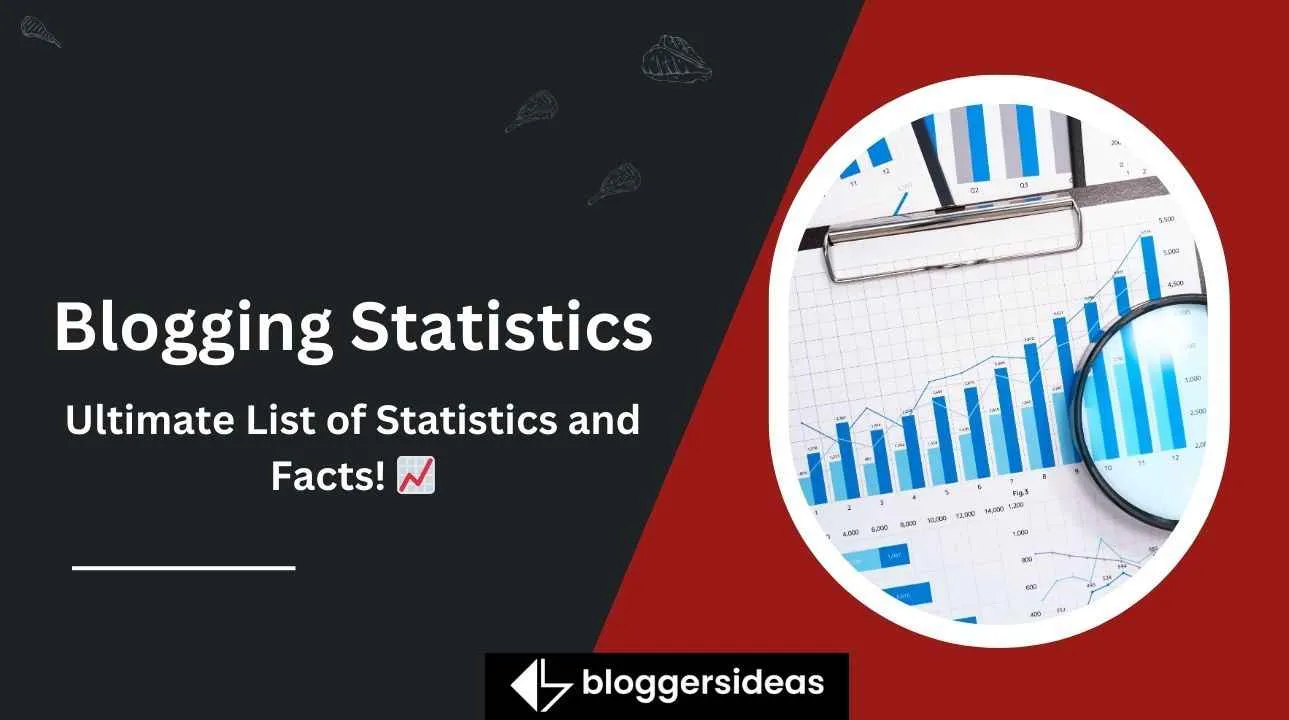Blogging has become a powerful tool for sharing knowledge, expressing ideas, and connecting with others. It’s fascinating to see how it has evolved over the years.
From the number of blogs worldwide to trends in reader engagement, these stats provide insight into the blogging world’s current state.
Whether you’re a seasoned blogger or just starting, understanding these numbers can help you navigate the blogging landscape more effectively.
Let’s explore some key blogging statistics that highlight its impact and growth.
| Category | Statistic |
|---|---|
| Blog Post Time | Approximately 4 hours to write a blog post |
| Blog Post Length | Average blog post length was 1,416 words |
| Regular Blog Readers | 77% of internet users were reading blogs |
| Blog Readers vs. Emails | 61% of Americans spend three times more time-consuming blog content than emails in 2023 |
| Blog Post Frequency | 44% of bloggers publish new content 3-6 times monthly |
| Longer Blog Posts | Only 14% of bloggers write blog content that’s 2,000+ words in length |
| Trust in Bloggers | Consumers are unsure if bloggers are trustworthy |
| Preferred Browser | 64% prefer Chrome for reading blogs |
| Impact of Image Loading | 53% of visitors leave if images on a blog don’t load |
| Factors Leading to Abandonment | Clutter, long paragraphs, poor-quality photos, difficult-to-read fonts, and other issues lead to 90% of visitors abandoning a website |
| Trustworthiness of Blog Design | A clean design accounts for 75% of a blog’s trustworthiness |
| Information Source Preference | 70% of consumers prefer understanding a brand from a blog post rather than an advertisement |
| Digital Research Before Purchase | 81% of consumers conduct digital research before making a purchasing decision |
| WordPress Views | Over 409 million people view over 20 billion pages each month on WordPress.com |
Statistics on the Growth of Blogging
Source: Pexels
- 73 percent of content authors said they profited from their blogs in 2016.
- There are 1.8 billion websites on the internet as of 2021.
- Only about 200 million of the 1.8 billion websites are active.
- With 900 million visitors at the beginning of the year & 1.7 billion by the end, 2016 was the most crucial year for website growth.
- A blog is not available on every website. There will be approximately 600 million blogs in 2021.
- Every year, around 2.5 million blog pieces are published.
- To break it down even more, there are around 6,912,000 posts produced each day and 4,800 posts posted every minute.
- Around 31 million blogs are active monthly in the United States alone.
- According to search engine optimization tools, internet users worldwide search for “how to start a blog” 121,000 times every month.
- More than 600 million blogs out of 1.9 billion websites worldwide were noted in 2023.
SEO Statistics for Blogging
- In 2019, a search was discovered to be the most popular source of traffic to blogs throughout all sectors.
- Barely 0.78 percent of web visitors click on a link on the 2nd page of Google searches.
- Google does not send traffic to 90.63 percent of online pages.
- In a year of activity, only 5.7 percent of blogs will score on the top page of Google.
- A meta description is missing from 25.02 percent of all ranked pages.
- SEO is the second most popular method for driving visitors to a blog, with 69 percent of bloggers investing in it each year.
- In 2020, 70 percent of bloggers will update outdated content, compared to only 53% in 2017.
- Bloggers who update old content as part of their SEO plan are doubly inclined to positive outcomes.
- A blog’s chances of ranking higher in search increase by 434%, as observed in 2023.
A Blogger Takes on Statistics:
Source: Pexels
- Many people find it difficult to find sufficient time to expand their blogs because blogging is a side business for them.
- 47 percent of bloggers struggle to obtain continuous organic traffic and attract visitors.
- Quality material is also a problem for 38 percent of bloggers who don’t have sufficient time to blog.
- For 19 percent of bloggers, bringing up relevant things to write about is challenging.
- Receiving support from inside organizations is the #1 challenge for 15% of bloggers.
- It takes about 4 hours on average to write a blog post in 2023.
- The average blog post length was reported as 1,416 words in 2023.
Statistics on Blog Readership and Consumption:
- Consumers read blogs on their computers in 83 percent of cases.
- Internet users devote at least 20 percent of their online time to content, such as blogs, tutorials, and vlogs.
- 68 percent of individuals read about businesses and goods that they are interested in.
- At least once a month, 57 percent of online consumers read content marketing titles.
- Custom content is preferred by 80% of individuals when learning about products. 70% of consumers would rather read an article about a brand than watch a commercial.
- Sixty percent of users appreciate reading material from their favorite brands that are relevant to them. 82 percent of users said that custom content makes them feel more at ease with a business.
- Custom content is valuable to 90% of individuals.
- In 2020, 46 percent of internet users accessed vlogs and blogs on a regular basis, up 12 percent from 2017.
- In 2017, 13 percent of females read cosmetics and beauty blogs on a regular basis, whereas 47 percent did not read these blogs at all.
- Consumers of blogs are unsure whether or not bloggers are trustworthy.
- In 2020, 43% of individuals believed that bloggers collaborated with the government.
- Consumers prefer Chrome to other browsers for reading blogs, with 64% preferring Chrome. Users place a premium on a blog’s functionality.
- If the images on a blog don’t load, 53% of visitors will go.
- Clutter, extended paragraphs, poor-quality photographs, difficult-to-read typefaces, and other issues lead 90% of visitors to abandon a website.
- A tidy design accounts for 75% of a blog’s trustworthiness.
- 70 percent of consumers would rather understand a brand from a blog post than from an advertisement.
- Consumers conduct 81 percent of their studies digitally before making a purchasing choice.
- More than 409 million people view over 20 billion pages each month on WordPress.com in 2023.
- 77% of internet users were reading blogs in 2023.
- 61% of Americans spend three times more time-consuming blog content than emails in 2023.
Statistics on Blog Frequency and Length:
Source: Pexels
- In 2019, 21 percent of bloggers said they spent 2 to 3 hrs on each blog article on average.
- In 2019, only 19 percent of bloggers spent more than six hours on each blog post.
- The typical time spent composing blog entries is expected to rise to 3 hours and 55 mins by 2020.
- In 2020, 31 percent of bloggers who devoted 6 or more hours to a blog post were more inclined to report positive results.
- The average blog article in 2014 was only eight hundred and eight words long.
- In 2020, the average length of a blog post will have nearly tripled to 1,269 words. Bloggers that create posts with a word count of 3,000 or more get 54 percent better results.
- The frequency with which blog posts were published reduced as the length of the posts grew longer.
- Twenty-two percent of bloggers post multiple times per month.
- Bloggers posted at least 6 times per week in 2014.
- Sacrificing article length for publication frequency has implications.
- Bloggers who post on a daily basis receive 55 percent greater outcomes than those who post once or twice a month.
- 44% of bloggers publish new content between three to six times monthly in 2023.
- Only 14% of bloggers write blog content that’s 2,000+ words in length in 2023.
Statistics on Blog Types and Content:
- How-to articles are by far the most popular sort of material, with 77 percent of bloggers writing them on a regular basis.
- According to 57 percent of bloggers, listicles are the 2nd most common post category.
- Bloggers are split 50/50 on whether or not to include news in their writings.
- Webinars, roundups, manuals, gated content, and interviews are all effective content formats, scoring a 33 percent efficacy.
- At least 1 image appears in 90% of average blog postings.
- Statistics appear in 54 percent of blog postings on the internet.
- Despite the fact that it is free and takes little effort, it results in a 37 percent increase in contributor quotations.
- Only 25 percent of blog postings include video.
- While using video in blog articles is not typical, it is highly successful. Bloggers who used video in their blogs got better results than those who used quotes, photos, and data.
- Only 3 percent of bloggers use more than ten photographs in their postings.
- The more video content a blog article has, the more likely it is to generate results.
- In fact, blogs containing ten or more photographs saw a 39 percent increase in traffic.
- Blog posts with 6-13 word long headlines tend to drive more traffic in 2023.
- Odd-numbered headlines perform better than their even-numbered counterparts in 2023.
Statistics on Blogging and Marketing:
Source: Pexels
- The amount of money spent on blog marketing has decreased over time.
- Spending was $700 million in 2018, down from $790 million in 2016.
- Blogs can create three times the number of leads per dollar spent as traditional marketing.
- In 2019, a whopping 97 percent of blogs used social media to market their material.
- For 66% of blog marketers, email marketing is effective.
- Social media (95 percent), blog posts & short articles (89 percent), and email newsletters are the top 3 types of content used by B2-B marketing (81 percent). Blogs are used by 31% of marketers to increase brand recognition.
- Blogs are used by 13% of marketers to nurture leads.
- Blog postings were used by 89 percent of content marketers in their content development strategy in 2020.
- Content marketing is used by 91 percent of B2B marketers as a strategic technique to attract and keep more customers.
- At least 1 full-time individual in command of content and marketing is employed by 53% of businesses.
- Content marketing is outsourced to agencies or freelancers by 47% of businesses.
- Sixty-six percent of businesses claim they are fully devoted to content marketing, whereas another 36 percent say they are only slightly committed.
- The content marketing efforts of 53% of B2B organizations have been moderately successful, according to the survey.
- Those companies who still do not possess a content marketing plan cite a lack of executive buy-in or cross-departmental cooperation as the reason.
- 65% of content marketers say they have a documented content strategy in 2023.
- 71% of B2B buyers consume blog content during their buyer journey in 2023.
Influence of Bloggers and Vloggers on Consumers’ Statistics
- When it came to making purchasing decisions in 2020, over two-thirds of web users looked to YouTube for advice.
- Furthermore, 13% made a purchase after seeing a product/service advertised by a vlogger or blogger.
- A blogger or vlogger’s recommendation was a crucial factor in 17 percent of consumers’ decision-making.
- 46 percent concur that they would consider information provided by a blogger or vlogger.
- Celebrity bloggers & vloggers directly influenced 12 percent of garment purchases in 2019.
- 61 percent bought something after seeing it on YouTube and being inspired by a vlogger or a blogger.
- The product was discovered on Instagram by 42% of those who made a purchase.
- However, there is a lack of trust in influencers in general.
- In 2019, an average of 86 percent of individuals did not believe what influencers stated on social media.
Statistics on Blogging Around the World:
Statistics on Blogging Platforms
- Tumblr has 496 million blog accounts as of April 2020, up from 463.5 million in 2019.
- Tumblr bloggers have created nearly 171.5 billion blog entries as of April 2019. In 2020, the United States accounted for 48.59 percent of desktop traffic on Tumblr, a visual blogging platform.
- Bloggers on Tumblr are both male and female (75 percent ).
- Every month, WordPress users create 70 million new blog posts & 77 million new comments.
- For the past 8 years, WordPress has always been the quickest-growing platform.
- Every month, WordPress receives an incredible 20 billion page views.
- Medium is a blogging platform with 200,000 to 400,000 paying subscribers.
- Mobile devices account for 68 percent of Medium’s traffic.
- Wix had more than 120 million users & 4.2 million premium subscribers in 2019.
- 43% of all websites on the Internet are powered by WordPress in 2024.
- Tumblr hosts over 518 million blogs, while WordPress hosts over 60 million blogs as of 2023.
FAQs
⏰ How much time does it take to write a blog post on average in 2024?
On average, it takes approximately 4 hours to write a blog post.
📱 How do mobile users impact blog consumption trends?
Mobile users are a significant portion of blog readers. Bloggers need to ensure their websites are mobile-friendly to cater to this audience.
📈 Are there any notable changes in blog marketing spending?
Blog marketing spending has decreased over time, but blogs continue to generate more leads per dollar spent compared to traditional marketing.
🔍 How do bloggers impact consumers' purchasing decisions?
Bloggers can influence purchasing decisions through product reviews, recommendations, and authentic content. A significant percentage of consumers consider bloggers' opinions when making purchases.
Also Read:
- Ecommerce Statistics
- Logo Statistics
- Nonprofit Statistics
- Social Media Statistics
- Top OTT Statistics
- Pinterest Statistics
- Video SEO Statistics
Conclusion: Blogging Statistics 2024
The statistics analyzed indicate that blogging continues to be a dynamic and influential component of the online world.
With millions of blogs and bloggers out there, competition is intense, but the potential for connection and sharing is vast. These statistics demonstrate that whether for personal expression, business, or education, blogs play a significant role.
By keeping up-to-date with these trends and figures, bloggers can enhance the positioning of their content to reach their intended audience, making their blogging journey both gratifying and impactful.
Sources: Orbit media, Statista, Growthbadget, Hubspot, Aherfs, Backlinko, GlobeNewswire, Medium









